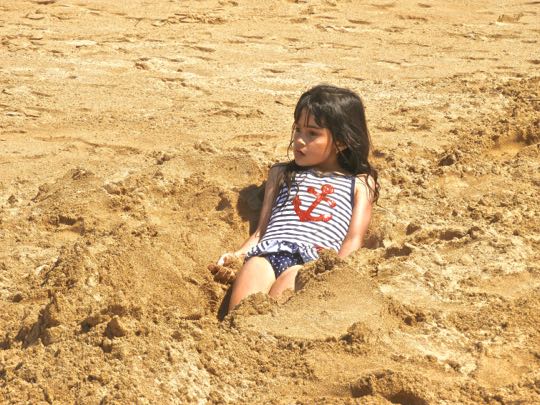Chacala may have (so far) avoided this fate because it is relatively remote from Puerto Vallarta. Thus, it has largely escaped the notice of those who jet in from afar, seeking resort destinations that have all the comforts and conveniences of home. Perhaps Chacala will undergo changes similar to Sayulita in the future. For now, it retains the slightly down-at-the-heels quality and off-the-beaten-track charm that Carole and I like.
The town's two main streets parallel the shore and are bisected by several short streets. Walking at a brisk pace, you could probably cover the whole "downtown" in 15 minutes or so. There are a number places selling nicknacks and other shops that sell or rent gear for swimmers, snorkelers, divers, and those favoring boogie or surfboards.
The southern portion of the beach is scattered with large rocks. However, near the waterline, the sand is smooth and walking is easy. Only a couple of people strolled the beach during the late morning when I took this shot. You'll likely encounter more folks than this at the northern part of the crescent, but it would still be a stretch call that area crowded.
Where the southern end of the shore turns out toward the point, the beach mostly disappears and the steep jungled slope comes right down to the water. In the upper left quadrant of the photo you can see a light colored structure built into the cliff (just above and slightly to the left of the figure on beach). That is the subject of my next photo.
One of the more unusual homes you will find in Chacala. The builder constructed the house as a series of steps from the rocky shore up the mountainside. Whoever lives there had better have good knees! Also, since the Pacific Coast of Mexico is subject to the occasional tsunami, the occupant had better hope s/he is in one of the upper levels when the wave arrives.
Most of the hotels and rental bungalows are located in the town. Few if any structures here have more than four stories. This provides a welcome relief from the glass and steel towers that dominate Puerto Vallarta. The structures along the beach are called palapas. Roofed with palm-fronds, their floors are beach sand. One of the main reasons we find Chacala so attractive is its human scale.
What to do in Chacala?
Boogie boarders frolic in the surf. Chacala has gentle surf and the water is usually calm. Big-wave surfers should probably look elsewhere. However these conditions are great for boogie boarders, swimmers, snorkelers, and those who just want to get wet to cool off.
Playing in the sand can also be entertaining. Beach sand seems to have a special attraction for small children and dogs. This little girl has nestled herself into some cool moist sand as she considers her next move.
Running, jumping, and digging in loose sand are among the favorite activities of canines, as well as kids. I have seen dogs vigorously digging on the beach just for the sheer joy of making the sand fly.
And, speaking of margaritas... It's hard to beat the cool shade of a beach palapa on a hot afternoon. As you gaze out over the blue Pacific toward the far horizon, you may find yourself "Wastin' away in Margaritaville". Jimmy Buffet would feel right at home here. My guess is, you would too.
This completes my posting on Chacala and my series on Mexico's Central Pacific Coast beaches. I hope you have enjoyed it. If so, please leave any thoughts or questions in the Comments section below or email me directly. If you leave a question, please include your email address so that I can respond.
Hasta luego, Jim












I agree the smaller beaches along the central coast are far more relaxing. The surf is also much calmer in the smaller beach areas. Saludos!
ReplyDeleteThanks for this useful series, Jim. Good for anyone, like us, who is looking for less well-known places to spend a quiet and scenic time at the beach.
ReplyDelete